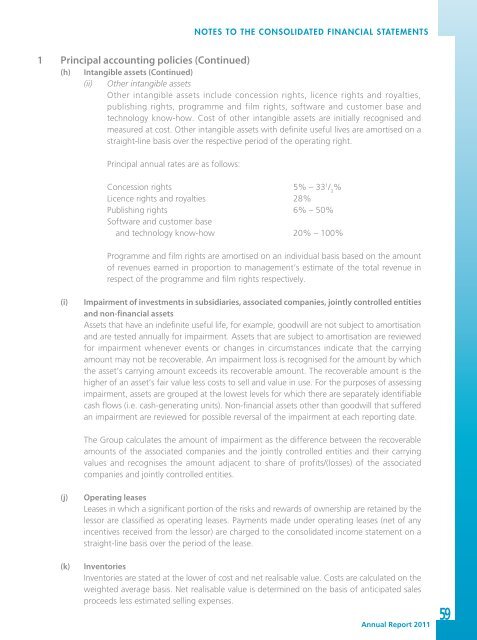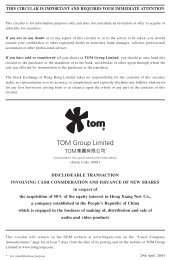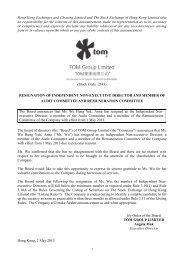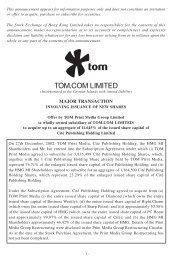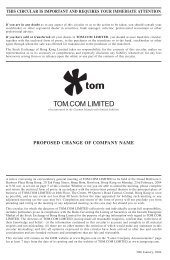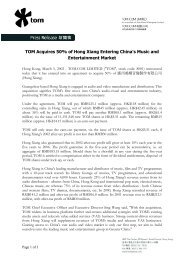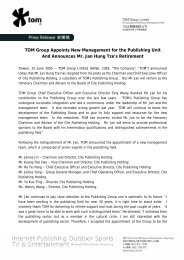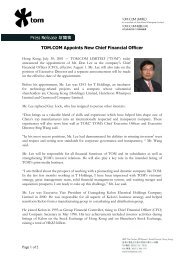2011 Annual Report - TOM Group
2011 Annual Report - TOM Group
2011 Annual Report - TOM Group
You also want an ePaper? Increase the reach of your titles
YUMPU automatically turns print PDFs into web optimized ePapers that Google loves.
NOTES TO THE CONSOLIDATED FINANCIAL STATEMENTS<br />
1 Principal accounting policies (Continued)<br />
(h)<br />
Intangible assets (Continued)<br />
(ii) Other intangible assets<br />
Other intangible assets include concession rights, licence rights and royalties,<br />
publishing rights, programme and film rights, software and customer base and<br />
technology know-how. Cost of other intangible assets are initially recognised and<br />
measured at cost. Other intangible assets with definite useful lives are amortised on a<br />
straight-line basis over the respective period of the operating right.<br />
Principal annual rates are as follows:<br />
Concession rights 5% – 33 1 / 3<br />
%<br />
Licence rights and royalties 28%<br />
Publishing rights 6% – 50%<br />
Software and customer base<br />
and technology know-how 20% – 100%<br />
Programme and film rights are amortised on an individual basis based on the amount<br />
of revenues earned in proportion to management’s estimate of the total revenue in<br />
respect of the programme and film rights respectively.<br />
(i)<br />
Impairment of investments in subsidiaries, associated companies, jointly controlled entities<br />
and non-financial assets<br />
Assets that have an indefinite useful life, for example, goodwill are not subject to amortisation<br />
and are tested annually for impairment. Assets that are subject to amortisation are reviewed<br />
for impairment whenever events or changes in circumstances indicate that the carrying<br />
amount may not be recoverable. An impairment loss is recognised for the amount by which<br />
the asset’s carrying amount exceeds its recoverable amount. The recoverable amount is the<br />
higher of an asset’s fair value less costs to sell and value in use. For the purposes of assessing<br />
impairment, assets are grouped at the lowest levels for which there are separately identifiable<br />
cash flows (i.e. cash-generating units). Non-financial assets other than goodwill that suffered<br />
an impairment are reviewed for possible reversal of the impairment at each reporting date.<br />
The <strong>Group</strong> calculates the amount of impairment as the difference between the recoverable<br />
amounts of the associated companies and the jointly controlled entities and their carrying<br />
values and recognises the amount adjacent to share of profits/(losses) of the associated<br />
companies and jointly controlled entities.<br />
(j)<br />
Operating leases<br />
Leases in which a significant portion of the risks and rewards of ownership are retained by the<br />
lessor are classified as operating leases. Payments made under operating leases (net of any<br />
incentives received from the lessor) are charged to the consolidated income statement on a<br />
straight-line basis over the period of the lease.<br />
(k)<br />
Inventories<br />
Inventories are stated at the lower of cost and net realisable value. Costs are calculated on the<br />
weighted average basis. Net realisable value is determined on the basis of anticipated sales<br />
proceeds less estimated selling expenses.<br />
<strong>Annual</strong> <strong>Report</strong> <strong>2011</strong><br />
59


